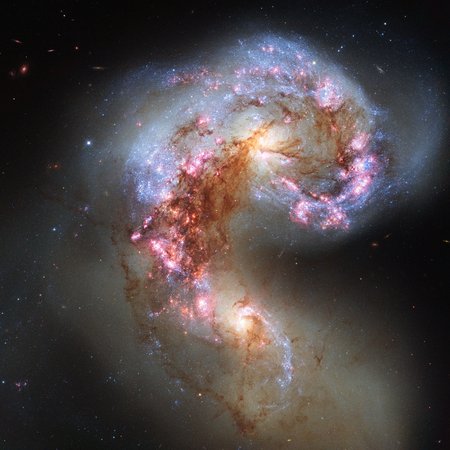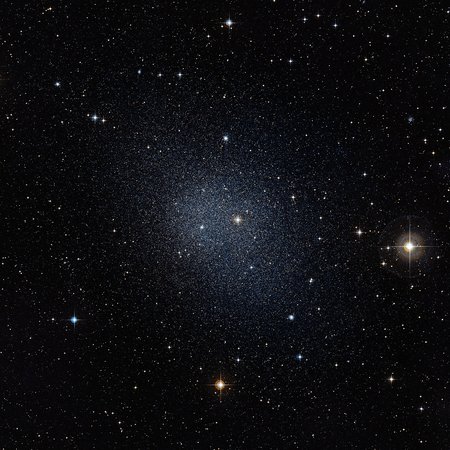Galaxies light up at Art Basel Miami Beach
On 30 November 2011 the light installation “eL” lighted up for the first time at the Art Basel Miami Beach. The 2.7 meter high chandelier was developed and realised by a cooperation of Astrophysicist Noam Libeskind, his father, American architect Daniel Libeskind and Zumtobel, an international supplier of integral lighting solutions.
The light emitted by the installation mimics and reproduces the cosmic light that fills the Universe. To achieve this, Noam Libeskind from the Leibniz Institute for Astrophysics in Potsdam used the CLUES simulations - a set of cosmological simulations that aim to reproduce the local universe. Each of the 1,680 LEDs of the chandelier is used to represent how light and mass evolve as the Universe expands from the Big Bang until today.
The idea is based on the theory that the Universe is around 14 billion years old and that its building blocks – galaxies like the Milky Way – grew larger as the Universe aged. As they grew larger, the light their stars emitted changed, visible as the LEDs emit different colours. State of the art simulations run on massive supercomputers were used to compress a billion years into one second so that the installation’s time loop plays back the history of the cosmos in 14 seconds and, in doing so, tells the story of how light came into being: how it was created and absorbed by the stars in the heavens.
About CLUES
The CLUES project (Constrained Local UniversE Simulations) is an international astrophysical collaboration with the goal to achieve a better understanding of the formation of our Local Group, a group of dozens of galaxies to which our Milky Way and Andromeda belong. The Local Group and its environment is the best observed region of the universe. The CLUES project relies heavily on numerical simulations performed at supercomputers in Germany, Spain and US. Predictions from such simulations about the dark matter distribution and gasdynamical processes which govern the formation of galaxies can be compared with detailed observations of our galactic neighbourhood. Partners of the CLUES project are the Leibniz Institute for Astrophysics Potdam (AIP), the Hebrew University of Jerusalem, the Universidad Autónoma de Madrid and the New Mexico State University.
On 30 November 2011 the light installation “eL” lighted up for the first time at the Art Basel Miami Beach. The 2.7 meter high chandelier was developed and realised by a cooperation of Astrophysicist Noam Libeskind, his father, American architect Daniel Libeskind and Zumtobel, an international supplier of integral lighting solutions.
The light emitted by the installation mimics and reproduces the cosmic light that fills the Universe. To achieve this, Noam Libeskind from the Leibniz Institute for Astrophysics in Potsdam used the CLUES simulations - a set of cosmological simulations that aim to reproduce the local universe. Each of the 1,680 LEDs of the chandelier is used to represent how light and mass evolve as the Universe expands from the Big Bang until today.
The idea is based on the theory that the Universe is around 14 billion years old and that its building blocks – galaxies like the Milky Way – grew larger as the Universe aged. As they grew larger, the light their stars emitted changed, visible as the LEDs emit different colours. State of the art simulations run on massive supercomputers were used to compress a billion years into one second so that the installation’s time loop plays back the history of the cosmos in 14 seconds and, in doing so, tells the story of how light came into being: how it was created and absorbed by the stars in the heavens.
About CLUES
The CLUES project (Constrained Local UniversE Simulations) is an international astrophysical collaboration with the goal to achieve a better understanding of the formation of our Local Group, a group of dozens of galaxies to which our Milky Way and Andromeda belong. The Local Group and its environment is the best observed region of the universe. The CLUES project relies heavily on numerical simulations performed at supercomputers in Germany, Spain and US. Predictions from such simulations about the dark matter distribution and gasdynamical processes which govern the formation of galaxies can be compared with detailed observations of our galactic neighbourhood. Partners of the CLUES project are the Leibniz Institute for Astrophysics Potdam (AIP), the Hebrew University of Jerusalem, the Universidad Autónoma de Madrid and the New Mexico State University.
Images
Light Installation “eL”
Big screen size [1000 x 1499, 320 KB]
Original size [2339 x 3508, 1.3 MB]





